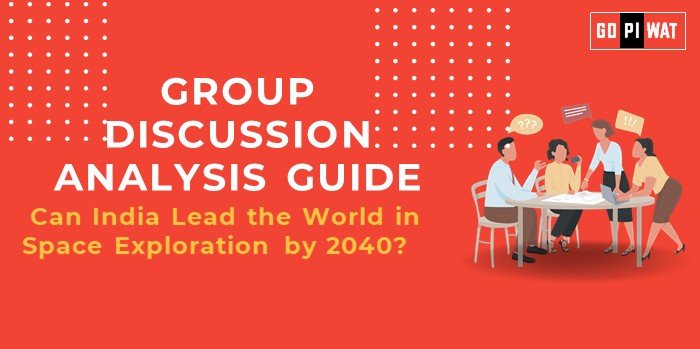📋 Group Discussion Analysis Guide: Can India Lead the World in Space Exploration by 2040?
🌐 Introduction
India’s Chandrayaan-3 mission marked a historic milestone in space exploration, solidifying its position as a rising global leader in this domain. The question now is whether India can translate these achievements into a leadership role in space exploration by 2040.
📊 Quick Facts & Key Statistics
• Chandrayaan-3 Success: On August 23, 2023, India became the first country to achieve a soft landing near the Moon’s south pole and the fourth overall to land on the Moon.
• Cost Efficiency: Chandrayaan-3 was completed on a $75 million budget, showcasing India’s cost-effective innovation.
• Private Sector Growth: A $119 million fund approved in October 2024 supports 40 space startups to foster innovation.
• Space Economy Projection: India’s space economy is projected to grow from $8 billion to $100 billion by 2040.
• Global Collaborations: The Proba-3 mission launched aboard India’s PSLV-XL rocket in December 2024, highlighting its reliability in international missions.
• Cost Efficiency: Chandrayaan-3 was completed on a $75 million budget, showcasing India’s cost-effective innovation.
• Private Sector Growth: A $119 million fund approved in October 2024 supports 40 space startups to foster innovation.
• Space Economy Projection: India’s space economy is projected to grow from $8 billion to $100 billion by 2040.
• Global Collaborations: The Proba-3 mission launched aboard India’s PSLV-XL rocket in December 2024, highlighting its reliability in international missions.
🌟 Stakeholders and Their Roles
- 🚀 ISRO: Core driver of India’s space missions, focusing on innovation and research.
- 🏛️ Government: Financial and policy support, including the new funding initiative for startups.
- 💼 Private Companies: Innovating and contributing to a growing global market share.
- 🌐 International Partners: Collaborating on advanced missions, as seen with ESA’s Proba-3.
- 📚 Academia and Research Institutions: Pioneering technologies like AI and cryogenics.
🏆 Achievements and Challenges
📌 Achievements:
- ✅ Chandrayaan-3 Success: Landmark mission in lunar exploration.
- ✅ Cost Leadership: Consistent delivery of missions at a fraction of competitors’ costs.
- ✅ Policy Reforms: Opening the space sector to private investment.
- ✅ Global Recognition: Reliable partner in global missions like ESA’s Proba-3.
📌 Challenges:
- ⚠️ Budget Constraints: Despite successes, India’s space budget remains modest.
- ⚠️ Technological Dependencies: Gaps in human spaceflight and advanced satellite technology.
- ⚠️ Geopolitical Hurdles: Limited collaborations due to global competition.
🌍 Global Comparisons:
- 🇺🇸 USA (NASA): Dominates interplanetary missions and reusable rocket technologies.
- 🇨🇳 China (CNSA): Plans for a lunar base by 2030.
- 🇪🇺 Europe (ESA): Collaborative leadership in space science.
🎯 Effective Discussion Approaches
- Opening Approaches:
- Data-Driven Start: “With a $75 million Chandrayaan-3 mission, India has redefined cost-effective space exploration.”
- Comparative Insight: “India’s cost efficiency challenges NASA and CNSA in redefining global leadership in space.”
- Case Study Mention: “The Proba-3 mission exemplifies India’s growing stature in global collaborations.”
- Counter-Argument Handling:
- Emphasize new private-sector initiatives addressing technological gaps.
- Showcase global partnerships mitigating challenges.
📈 Strategic Analysis of Strengths & Weaknesses
- Strengths: Low-cost innovation, increasing private sector participation, growing international credibility.
- Weaknesses: Limited budget, gaps in cutting-edge technology.
- Opportunities: Expanding private investments, global leadership in cost-efficient missions.
- Threats: Intense competition from NASA, CNSA, and ESA.
🗣️ Structured Arguments for Discussion
- 👍 Supporting Stance: “India’s Chandrayaan-3 success and $100 billion projection underline its leadership trajectory.”
- 👎 Opposing Stance: “Technological and budget constraints could limit India’s leadership potential.”
- ⚖️ Balanced View: “India’s trajectory is promising but needs strategic focus on funding and technology to lead.”
🎓 Connecting with B-School Applications
- 📌 Real-World Applications:
- Innovations under resource constraints—valuable in finance and operations.
- Managing public-private partnerships.
- ❓ Sample Questions:
- “What lessons can B-school students learn from India’s cost-efficient space missions?”
- “How can the private sector drive India’s space ambitions?”
- 💡 Insights for B-School Students: Focus on resource optimization and international collaboration; leverage policy insights for sustainable development.


